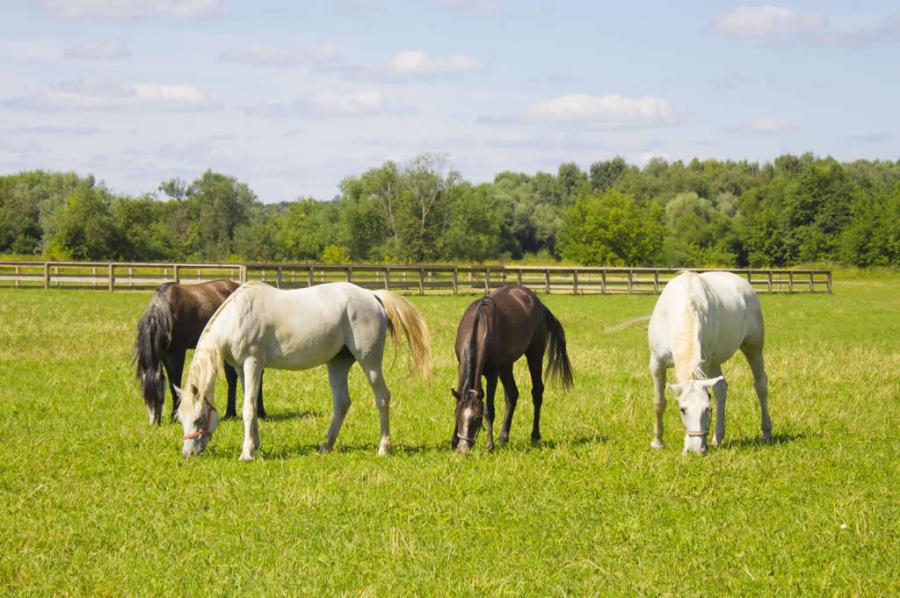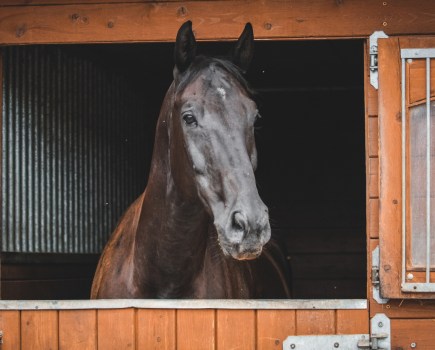Is your paddock a quagmire after a long, wet winter? You’re not alone. As we step into spring, fields will have suffered their fair share of the unpredictable weather, including rainfall and snow, making them nothing more than a muddy mess. Acting now with correct horse field management will help to restore grazing and help you take care of a horse this season.
There are several steps to take, starting as soon as the ground starts to dry. A good horse field management plan will include rolling and harrowing, reseeding and fertilising, as well as taking steps to prevent the land being over-grazed and giving it time to recover.
When the ground dries
It’s inevitable that once the ground begins to dry, there’ll still be an amount of work to be done before the grass is in plentiful supply.
“Grassland tends to revert back to indigenous varieties overtime, which is what we more commonly call ‘weed grasses’,” explains Jonathan Cox of Suregrow UK. ” Variable weather speeds up the rate at which grass reverts back to indigenous varieties, as the fertility in the ground will have seeped away due to continuous rainfall. This type of grass is not only invasive but is less palatable, less productive and less nutritious.”
Horse field management: divide your land
Depending on how much grazing space you have available, you may need to section off areas of your paddock so that you can prepare areas and allow them to repair after winter grazing, while still giving access to grazing in the meantime, advises land management expert Jenna Scott from Boston Seeds.
“One way to do this is strip grazing in the spring, which allows your horse to graze smaller areas when the grass is starting to grow more and the sugars in the grass are more intense,” says Jenna. “This can in turn help with sudden energy surges and help minimise the risk of weight gain and associated laminitis.”
Harrow/aerate the field
The best time to harrow a field is in the spring. Harrowing removes any dead grass and will help to level out bumps in the ground which can cause injuries to you and your horse.
“This is best done when it’s warm and dry, and a few days after a rain shower. It will also help with air movement in the soil and help water infiltration,” explains Jenna. “If the ground is particularly compacted and you have noticed certain areas holding water over the winter, now is also the ideal time to go over with an aerator to help with drainage.
“Allowing water to drain away freely will increase grass growth and help prevent areas from becoming waterlogged.”
Reseed and roll the field
The best solution to resolve heavily poached areas such as gateways and around feeding troughs is to get them re-seeded using easily established, fast-growing, hard-wearing grass. Re-seeding is a key part of horse field management.
“A seed that will germinate at lower temperatures than normal grass seed and can be spread by hand makes it an efficient and quick application process,” says Jonathan. “Before reseeding, it’s important harrow the area. After reseeding, roll the area. This should take place immediately after rainfall.”
Ground conditions should be such that tractor wheels leave a mark that will then be removed by the roller.
“Rolling is a good thing to do if the field is badly rutted, while harrowing will also help alleviate some ruts and will fluff up the top layer of soil, which will then help with providing a good seed bed into which to overseed,” adds Jenna.
“If the ground is too hard the seed will germinate but not be able to put its roots down. Unfortunately, there is no magic wand for these issues and lightly rolling the area will help best with rutted areas. Harrowing will help somewhat, but is better for preparing a good seed bed.”
Horse field management: weed control
Before sowing any new seed, you need to tackle any weeds. A selective weedkiller will tackle the weeds while not harming the grass. Weeds can take a lot of nutrients from the soil, leaving very little left for the grass.
As well as weeding, take the opportunity to remove any poisonous plants. Besides the obvious ragwort, a lot of weeds can cause problems or, if eaten in quantity, can prove toxic to horses. It’s important to be able to recognise sycamore, bracken, yew, acorns and deadly nightshade.
Keeping an eye on your horse’s paddock for dangerous plants is a year-round job, but weeds can become more of a problem after winter as the land may be in poor condition. Speak to your local land management specialist to discuss the best weed control options for your fields.
Consider fertilising the field
Fertiliser is probably the most overlooked area in any paddock maintenance schedule. Grass, like any other living thing, needs nutrients to grow. Certain soils hold nutrients better than others, and over-grazed paddocks, unproductive paddocks, and newly seeded paddocks are all reasons why you should increase the nutrients in the soil to improve grass growth.
Horses shouldn’t graze fertilised fields immediately though, so you’ll need to factor this into your turnout plan. Liaise with your fertiliser supplier for exact timings on when it’s safe to let your horse graze the field again.
“Fertiliser is made up of NPK — nitrogen (N), phosphorus (P) and potassium (K). The ratios of these are adjusted depending on the fertiliser’s intended use,” explains Jenna. “Apply fertiliser to your paddock at 3-5 bags (20kg) per acre using a spreader. This will ensure that you are applying fertiliser evenly across your paddock, avoiding either scorching the grass by applying it too thickly, or missing areas. It is advisable to keep livestock off the area until the granules have fully dissolved.”
Horse field management — top tip
“If your grass has done surprisingly well over the winter, but after harrowing and tackling any weeds there are gaps in your sward, to prevent weeds from taking a hold you will need to over-seed in these areas,” advises Jenna.
“If your horse is prone to laminitis you will need a ryegrass-free mixture. If your area is badly poached and you wish to rejuvenate the area completely, provide a top-quality grazing mixture that will tolerate close grazing while maintaining a tight sward.”
Bear in mind that reseeding takes a bit of planning, because horses shouldn’t be grazed on new grass until it is well established. Make sure you have enough space to graze your horse elsewhere while the new grass is growing. Once your new grass is well established, you need to gradually reintroduce your horse to it, giving their digestive system time to adapt.
Check out our subscription offer










